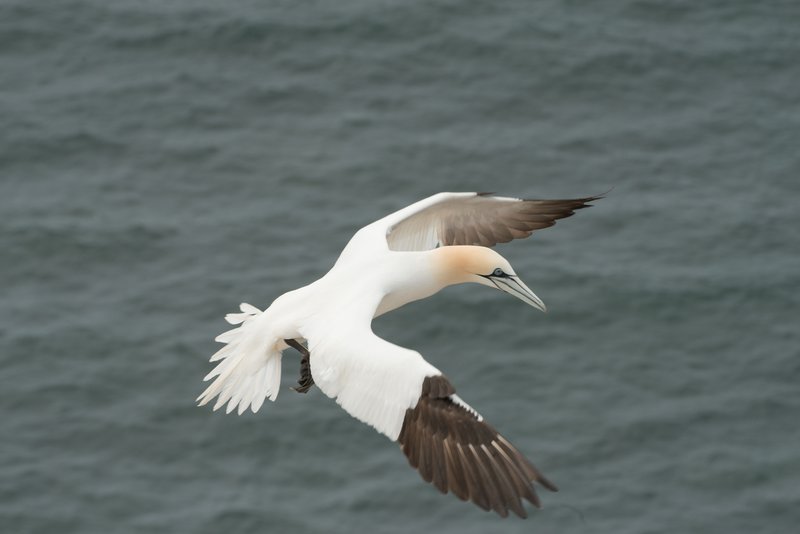Bonn/ Kiel, 17 April 2019:
What do gulls, robins and curlews have in common? They are travelling over the sea, resting, foraging or on their way between breeding and wintering grounds. And: they can all come into conflict with offshore wind turbines. One of the topics of the BIRDMOVE project, which is funded by the German Federal Agency for Nature Conservation (BfN), is the impact of offshore wind turbines on migrating and resting birds and seabirds.
In the meantime, technical progress, especially the downsizing of transmitters to mini formats, makes it possible to analyse the migratory movements not only of larger sea and water birds, but also of small songbirds over the sea. "Satellite telemetry is already being used successfully for many seabird species. The transmitters with built-in GPS, worn as backpacks, tell us in great detail which flight paths individual animals take," explains Prof. Beate Jessel, President of BfN. "The flight paths over the sea or at night, which largely elude our direct observation, are particularly informative. Here, different behaviours, also with regard to offshore wind turbines, could be determined for different species, for example song thrushes and redwing, curlews and gannets. For example, some species avoid the wind farms, others are attracted."
As part of the "BIRDMOVE" project, cooperation with French and Estonian researchers made it possible, for example, to record the migratory routes of curlews from the Atlantic coast across the North Sea and Baltic Sea to the Russian breeding grounds. The birds migrated across the open Baltic Sea in a typical broad-front migration and their flight paths also crossed existing offshore wind farms. Due to technical developments in GPS data loggers, it was possible to record flight altitudes for seven curlews. Although some of the birds migrate at altitudes of several kilometres, most of them fly below 300 metres. Thus, there was a clear overlap with the height of wind turbines or their rotors.
Scientists are also intensively studying the behaviour of various seabird species in and around offshore wind farms. Professor Stefan Garthe from Kiel University describes the differences: "Seabirds living at sea often clearly avoid offshore wind farms. However, this strongly depends on the bird species. While gannets usually fly around the wind farms in search of food, gulls spend more time in the wind farms. For all bird species, however, we see significant differences between individuals."
For the songbird species that also migrate over sea in large numbers, there is a particular lack of information on their behaviour at sea and on the coast. Only very small, non-GPS transmitters can be carried by robins and similar species. As part of the BIRDMOVE project, a team from the Institute of Bird Research (Bird Station Heligoland) set up a network of antennas spanning the German North Sea coast without any gaps, which can receive the signals from these transmitters. This made it possible for the first time to record detailed movements of songbirds along the coast. For example, some birds migrate along the coastline, but others of the same species migrate to the open sea.
In the German Bight, radar devices, cameras and microphones are also used to record bird migration. For more than twelve years, migrating birds were recorded on the research platform FINO 1. During this time, several offshore wind farms were built, and it was shown that during the day the vast majority of birds avoid the turbines and at least the risk of collision is significantly reduced. However, there are still major gaps in our knowledge, for example about the effects of such avoidance behaviour or also about the collision risk at night. At night, and especially in bad weather, the recording of small birds has so far been technically almost impossible.
BfN President Prof. Beate Jessel therefore emphasises: "In the first years of the expansion of offshore wind energy, we paid particular attention to the effects of wind farms on marine mammals and large seabirds. However, the findings from BIRDMOVE and a number of other research projects make one thing very clear: there is still an urgent need for research, especially with regard to other migratory bird species and also bats, in order to better assess the need for action."
Background information:
In recent years, the Federal Agency for Nature Conservation (BfN) has already initiated and funded extensive research projects with various renowned university institutes and also companies. Knowledge about increased collision risk, barrier or attraction effects and habitat loss has already been significantly increased as a result.
At a recent international conference in Berlin, the possible effects of offshore wind power on bird migration were discussed. Almost 100 scientists, representatives of the authorities, planners and wind farm operators from eleven countries accepted the invitation of the Christian-Albrechts-Universität zu Kiel, the Institute for Bird Research "Bird Station Heligoland" and the companies Gavia EcoResearch and Avitec Research GbR for a professional exchange. The project participants and other experts presented the current state of research in scientific lectures. The conference was part of the "BIRD-MOVE" project funded by the Federal Agency for Nature Conservation with funds from the Federal Ministry for the Environment. In addition to the current state of knowledge on the flight paths of seabirds and land birds over the open sea, the applicability of these new findings to the field of offshore wind power was also discussed.

